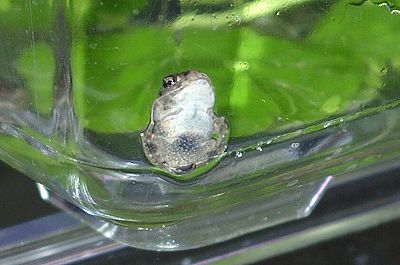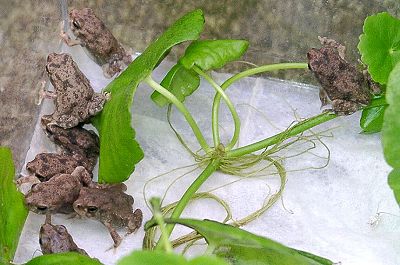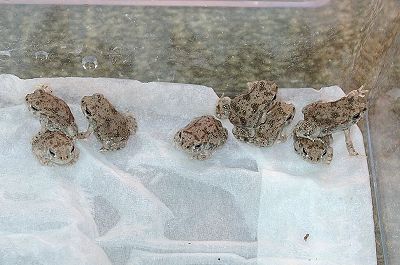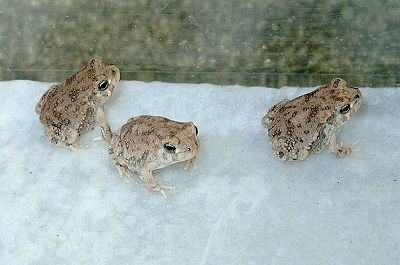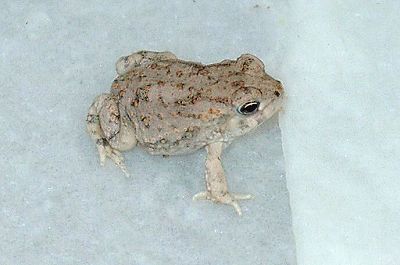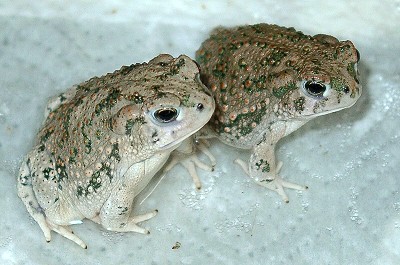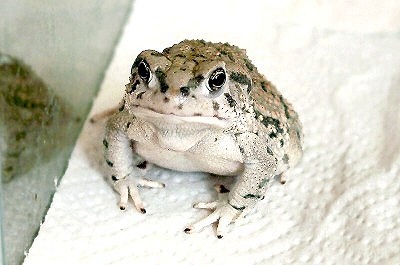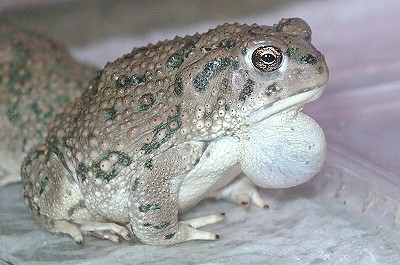Developement up from metamorphosis: 23rd day after spawning/finished metamorphosis tadpole tail completely gone in the fastest developped. The young toadlets have typical toad eyes and shape. They are very calm and do not flee if handling them.
2nd day after metamorphosis The first toadlets start eating micro sized crickets and get active again, approx. 80 % of the tadpoles are in metamorphosis or already toadlets. My white tadpole has visible hind leg bases now and has grown to approx. 2,5 cm - perhaps because it meanwhile is one of the last tadpoles in the fish tank.
6th day after metamorphosis The skin is dry and warty as typical for toads.
12th day after metamorphosis The biggest toadlets are 1,5 cm. The dark blotches at the lower back of the young toads in many young resembles a smily.
16th day after metamorphosis The biggest juveniles measure approx. 2 cm. The top of the warts have an orange colour now which makes the darker blotches less visible.
57th day after metamorphosis Most toadlets now have a much darker colour. Spots and stripes have changed to a dark gray-green. The biggest toadlets measure approx. 4 cm.
70th day after metamorphosis As the thumb usually is hidden under the body I only by coincidence noticed that some of the young have developped big dark nuptial pads. These young also have a bigger skin fold. Colour of the dark pattern now is mostly dark gray.
86th day after metamorphosis The toadlets measure approx. 5-6 cm. Some further young have developped nuptial pads. The best developped even have a small vocal sac which if unfolded looks like if the toad had swallowed a marble. The small males even start trying to call inspite of the vocal sac definitely has not fully developped.
130th day after metamorphosis (3rd October 2002) The biggest toadlet has a size of approx. 7,5 cm - it is nearly as big as its father. Developement of vocal sac in most male juveniles seems to be completed. A few only just now start developement to a male. Only one of 8 toadlets still might be a female. Remark: I myself did not have any losses of my young toads at the beginning, but I reared the largest tadpoles only anyway. Friends of mine who also cared for tadpoles of my toads lost a lot of newly metamor- phosed toadlets which developped from very small tadpoles and therefore were very small, too. Others, who kept their tadpoles at only 20°C noticed that metamorphosis took place some weeks later than under the conditions I offered. But tadpole size at metamorphosis was approx. the same as if kept warmer. The overall rapid deveolpement of my juveniles turned out to be a result of feeding too much. 4 weeks after start of winter dormancy half of the young started dying. Examination of one dead toadlet turned out that my toads carry Dermosporidium and that the desease possibly broke out because of the combination of the juveniles unusual fast developement and the cold temperatures during winter dormancy. As time went by it turned out that not only the toadlets were effected by the desease. All my Bufo speciosus had more or less serious symptoms. I was able to save the life of some of the young and the adult females for some time by medication, but the desease broke out again over a period of a several months. Half a year later all Texas Toads had died. Friends, who rised tadpoles of my Bufo speciosus, did not have any problem with Dermosporidium and the toads meanwhile are adults and still healthy. My Bufo cognatus never seemed to be effected by the desease. Now it is 2 years later and they still do not show any symptoms, but I did not risk cold hibernation any more. The toads spend winter time in their terrarium at approx. 15°C. My conclusion: As I combined a several factors from the beginning I am not sure what actions were important for breeding success. Providing the following conditions breeding was successful: After a 10-weeks long dormancy at approx. 8-12°C keep the toads wet for approx. 2 months and spray a several times per day. Substrate shoud be getting moist or even wet. Feed more often than usual. To encourage activity you may rearrange terrarium furnishings repeatedly or furnish the terrarium more simple. Change substrate often. Increase lighting time and use more powerful lighting (additional lighting tubes for example PowerGlo and SunGlo). Perhaps offer a place with warm bottom (for example place the electic device of the lighting tubes at one side of the terrarium). As soon as the male has nuptial pads on thumb and forefinger (beige seems to be normal), keeps his vocal sac in starting position and repeately "belches" rebuild the terrarium to a permanent rain terrarium. Strong breeding mood the soonest does occur after approx. 2 months of humid keeping conditions. I won't move my toads to the water container any sooner the next time. For installing a rain system all you need is a small pump connected with a tube up to the ceiling which is ending in a tube with holes (as common for external filters for fish tanks). You should cover the suction side of the pump with foam or tights material to prevent suction of dirt which might damage the pump or later spawn. For to lean on and spawning you should place a lot of water plants (plastic plants should also work) in the water and a little island (for example 2 brick stones). The males call and start amplexing from there. The first day water level should be only as high as the toads shoulders (they should be able to sit relaxed in the water). Thereafter water level may be increased by some further cm until the toads start to swim and dive. Some days old crane water was fine for my toads. Water temperature should be around 25°C (fish tank heater). In case the toads still are not likely to breed after some days, you should move them back to the wet terrarium. Somewhat later you may repeat the trial in the rained water container. It is best soon to move the spawn to a several small fish tanks or to use one big. Care for good aeration of the water. Water temperature approx. 20-25°C. If available provide living water plants and algae. Offer fish food tablets (z. B. TabiMin und Spirulina). If necessary change water. Exchange of water using 3/4 fresh tap water did not have any negative effect in my tadpoles. Do not keep too many tadpoles together, as they then will grow larger (1 tadpole per liter water seems to be optimum. If you change water daily by 3/4 and permanently check the fish tanks max. as many as 2 tadpoles per liter.) Hind leg development starts up from 12th day after spawning, up from the 21st day the arms break through. Move tadpoles having arms to a container with only 1 cm water level and plants for climbing out of the water. Up from the 23rd day the tail is reduced or gone, up from the 25th day toadlets start eating. When the toadlets are no more very small only feed 2-3 times per week. Bufo cognatus should be likely to breed under same conditions as for Bufo speciosus.
|
||||||||||||||||||
